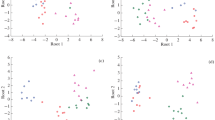Abstract
Monoamines and their metabolites have been measured by high performance liquid chromatography with electrochemical detection, in control rabbit carotid bodies and under several experimental conditions: 1) at different times (3 h, 6 h, 24 h, 48 h) after intravenous injection of reserpine (5 mg/kg); 2) 14 days after sympathectomy; 3) 14 days after section of the carotid sinus nerve. The results were analyzed with probability plotting methods. Dopamine was the most important monoamine in the carotid body (CB) and its variations were very large. It was almost entirely depleted by reserpinization without simultaneous increase in 3,4-dihydroxyphenylacetic acid. Sympathectomy increased dopamine content but did not change noradrenaline content. However data analysis suggested that noradrenaline might be compartmented in two pools: one with a large variance, located in the type I cells was increased after sympathectomy, the other, more constant, located in the sympathetic nerve endings was entirely depleted after sympathectomy. Section of the carotid sinus nerve increased dopamine and noradrenaline and quadrupled the serotonin content of the CB. It is proposed that carotid sinus and sympathetic innervations regulate the monoamine metabolism of the CB.
Similar content being viewed by others
References
Anton AH (1974) A simple, reliable and rapid method for increasing the responsiveness of the glassy carbon electrode (GCE) for the analysis of biogenic amines by high performance liquid chromatography with electrochemical detection (LCEC). Life Sci 35:79–86
Daly M de Burgh, Lambertsen CJ, Schweitzer A (1954) Observations on the volume of blood flow and oxygen utilization of the carotid body in the cat. J Physiol (Lond) 125:67–89
Dearnaley DP, Fillenz M, Woods RI (1968) The identification of dopamine in the rabbit's carotid body. Proc Roy Soc B 170:195–203
Fidone SJ, Gonzalez C, Yoshizaki K (1982) Effects of low oxygen on the release of dopamine from the rabbit carotid body in vitro. J Physiol (Lond) 333:93–110
Fidone SJ, Stensaas LJ, Zapata P (1983) Sites of synthesis, storage, release and recognition of biogenic amines in the carotid bodies. In: Acker H, O'Regan RG (eds) Physiology of the peripheral arterial chemoreceptors. Elsevier, Amsterdam, pp 21–44
Hanbauer I (1983) Biochemical aspects of putative neurotransmitters in the carotid body. In: Acker H, O'Regan RG (eds) Physiology of the peripheral arterial chemoreceptors. Elsevier, Amsterdam, pp 133–148
Hanbauer I, Hellstrom S (1978) The regulation of dopamine and noradrenaline in the rat carotid body and its modification by denervation and by hypoxia. J Physiol (Lond) 282:21–34
Karoum F, Speciale SG, Wyatt RJ (1979) Biochemical characterization of the rat sympathetic ganglion: pharmacological effects of reserpine on ganglionic catecholamines. J Pharmacol Exp Ther 211:706–710
Koelle GB (1970) Neurohumoral transmission and the autonomic nervous system. In: Goodman LS, Gilman A (eds) Pharmacological basis of therapeutics. Macmillan, New York, pp 402–441
Leitner LM, Roumy M, Verna A (1983) In vitro recording of chemoreceptor activity in catecholamine-depleted rabbit carotid bodies. Neuroscience 10:883–891
Mir AK, Al-Neamy K, Pallot DJ, Nahorski SR (1982) Catecholamines in the carotid body of several mammalian species: effects of surgical and chemical sympathectomy. Brain Res 252:335–342
Purves MJ (1970) The role of the cervical sympathetic nerve in the regulation of oxygen consumption of the carotid body of the cat. J Physiol (Lond) 209:417–431
Ruckebusch M, Sutra JF (1984) On the significance of monoamines and their metabolites in the cerebrospinal fluid on the sheep. J Physiol (Lond) 348:457–469
Sørensen SC (1976) The ultrastructure and catecholamine content of the carotid body during chronic hypoxia. In: Paintal AS (ed) Morphology and mechanisms of chemoreceptors. Vallabhai Patel Chest Institute, Delhi, pp 260–264
Verna A (1979) Ultrastructure of the carotid body in the mammals. Int Rev Cytol 60:271–330
Wilk MB, Gnanadesikan R (1968) Probability plotting methods for the analysis of data. Biometrika 55:1–17
Zapata P, Hess A, Bliss EL, Eyzaguirre C (1969) Chemical, electron microscopic and physiological observations on the role of catecholamines in the carotid body. Brain Res 14:473–496
Author information
Authors and Affiliations
Rights and permissions
About this article
Cite this article
Leitner, L.M., Roumy, M., Ruckebusch, M. et al. Monoamines and their catabolites in the rabbit carotid body. Pflugers Arch. 406, 552–556 (1986). https://doi.org/10.1007/BF00584019
Received:
Accepted:
Issue Date:
DOI: https://doi.org/10.1007/BF00584019




